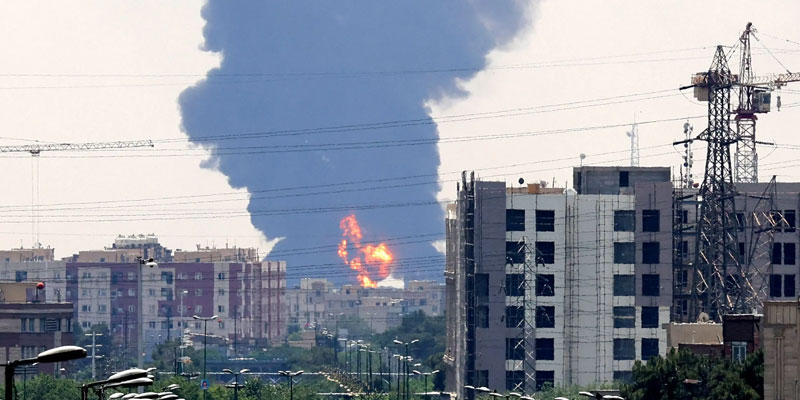The Iran-Israel Conflict Intensifies
The protracted tensions between Iran and Israel entered a dangerous new phase this week with the confirmed use of cluster munitions by Iranian forces. On Thursday, Iran launched a missile at Israel that, according to the Israeli military and its embassy in Washington, carried multiple explosive submunitions—a type of weaponry widely condemned for its indiscriminate and long-lasting effects on civilian populations.
This marked the first confirmed use of such weapons in the ongoing week-long conflict, triggering alarm among military analysts, human rights organizations, and foreign governments.
Cluster munitions are weapons designed to scatter smaller bomblets—each capable of causing lethal damage—over a wide area. These submunitions are packed inside a central container and released mid-air, spreading out in all directions. Unlike precision-guided missiles, these bomblets are unguided and fall indiscriminately, making them especially dangerous in urban and populated areas.
Their primary military purpose is to maximize damage across a large zone, hitting not just enemy personnel and vehicles, but often also non-combatants. These weapons can be launched via various systems, including artillery shells, missiles, and air-dropped bombs. A single artillery shell might carry dozens of bomblets; some rockets, like the U.S.-developed MLRS variants, can release hundreds.
While the U.S. ceased production in 2008 in response to humanitarian concerns, many stockpiles still exist globally, and Iran’s use of these weapons is a stark reminder of their continued threat.
The Attack: How Iran Used Cluster Munitions
According to Israeli defense sources, Iran launched a ballistic missile equipped with a cluster warhead toward central Israel. The missile’s warhead reportedly split at an altitude of around 7 kilometers, dispersing an estimated 20 bomblets across an 8-kilometer radius.
One of the submunitions reportedly struck a residential building in Azor, causing structural damage. Thankfully, no casualties were reported. However, many bomblets failed to detonate, turning them into latent landmines. The Israeli Home Front Command located and neutralized at least 20 unexploded submunitions, cautioning civilians not to approach any missile fragments.
Brigadier General Effie Defrin stated, “The terror regime seeks to harm civilians and even used weapons with wide dispersal in order to maximise the scope of the damage.”
This attack, according to the Israeli embassy, demonstrates Iran’s deliberate attempt to target densely populated civilian areas, a move described as a violation of international humanitarian law.
Why Cluster Munitions Are So Dangerous
The core danger of cluster munitions lies in their indiscriminate spread and the high failure rate of their bomblets. Many of these submunitions do not explode on impact, remaining active for years or even decades. In effect, they become unmarked, deadly landmines—a hazard for civilians long after the conflict ends.
Dud rates vary depending on the technology and age of the weapon. Western-made munitions typically have lower failure rates (as low as 2%), while older or less sophisticated variants, like those possibly used by Iran, can fail at rates exceeding 40%.
Daryl Kimball, Executive Director of the Arms Control Association, noted that Iran’s missiles are often imprecise, compounding the danger to non-military targets. “They are egregious weapons with wide-area destruction, especially if used in civilian populated areas,” he said.
The 2008 Convention on Cluster Munitions explicitly bans the use, development, and stockpiling of these weapons. 112 countries have signed it, but notably absent are Iran, Israel, Russia, Ukraine, and the United States—nations that continue to use or maintain stockpiles of cluster munitions under certain conditions.
Could Iran Be Developing MIRV Capabilities?
Following the strike, Israeli defense forces began examining recovered missile fragments to assess whether the missile contained elements of a MIRV system—Multiple Independently Targetable Reentry Vehicles. While MIRVs are distinct from cluster munitions, they share a basic principle: multiple warheads from a single missile.
Unlike bomblets, MIRV warheads are individually guided and can be directed at specific, separate targets, making them a strategic nuclear threat when paired with long-range ballistic missiles.
While no official confirmation has been made, even the speculation reflects a growing unease in the region that Iran’s missile technology may be more advanced than previously believed.
Global Response and Legal Landscape
The use of cluster munitions has long drawn international condemnation. While several nations, including the U.S., have argued for “exceptional use” cases—like recent transfers to Ukraine to counter Russian aggression—most of the world views these weapons as inherently indiscriminate and incompatible with modern humanitarian standards.
Iran’s deployment of cluster munitions against Israel raises two critical concerns:
· Escalation of regional conflict—particularly with Israel’s potential retaliatory measures.
· Civilian safety, as unexploded bomblets could pose a long-term threat to communities, children, and post-conflict reconstruction.
The incident also puts pressure on non-signatory nations to reconsider their stance on the 2008 treaty. The humanitarian risks are not abstract—they are now real, immediate, and visible.
A Dangerous Precedent
Iran’s use of cluster munitions in the ongoing conflict with Israel is a deeply troubling development—not just for its immediate impact, but for the precedent it sets in modern warfare. These weapons, by their very design, blur the line between combatant and civilian, battlefield and home.
Even though this attack resulted in no direct casualties, it underscores the thin line between tactical objectives and strategic recklessness. The legacy of cluster munitions is not just their explosion, but their lingering presence, their randomness, and their ability to kill long after the fighting ends.
As the world watches the Iran-Israel conflict unfold, one truth becomes painfully clear: the reintroduction of banned or condemned weapons into active theatres of war risks dragging global warfare back into darker, less humane eras. It is now up to the international community to ensure that this line is not crossed again.
(With agency inputs)






















